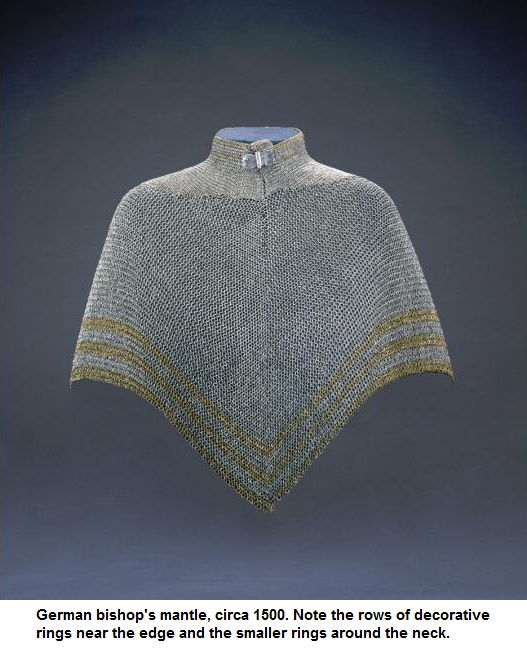This is a very special submission that is a really, really in depth discussion of everything about mail (commonly referred to as chainmail). Due to being so in depth, it’s also quite long so I’ve placed it behind a cut. It covers:
- The origins and history of mail
- How mail actually protects you
- How it evolved throughout history and improvements in armor
- Examples of mail as worn by different cultures
- References and links for further study
If you’re a creator interested in knowing more about mail so you can incorporate it in stories, designs or any other production – I highly recommend this article.
– wincenworks
machiavellianfictionist submitted:
This series of articles will try to explain in simple terms how several types of historical body armor function and are supposed to look like. I will mostly focus on Europe from late antiquity onward, though I may have a few things to say about Middle-Eastern and East Asian armor. This first part will focus on mail armor.
It goes all the way back to at least the fourth century BCE, and it’s widely believed to have been invented by the Celts. The oldest example found so far comes from the tomb of a Dacian chieftain in Romania. It was extremely rare for a warrior to be clad in mail back in those days, perhaps only reserved for chieftains or champions. Celtic warriors who couldn’t afford armor simply wore regular clothes, though some went into battle topless or even naked to avoid the risk of infection from fabric entering their wounds.
Soon the Romans adopted mail and it became the standard armor for their soldiers. Through them it reached the Sassanid Empire and the entirety of Asia. It remained the most popular and common type of armor all the way to the late middle ages. Even during the Renaissance it was used to complement other types of European armor, and in some middle-eastern countries like India, Turkey or Iran it was still being used by the nineteenth century.
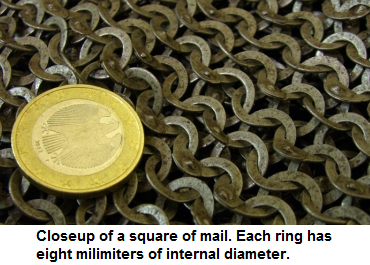
Mail armor at its most basic is a flexible sheet of metal formed by a series of interlinked rings. The most common pattern is nowadays known as four-in-one, where each ring is linked to four other, but most Japanese mail had a six-in-one pattern. Three different types of rings can be identified in historical mail: butted, riveted and solid. Butted and riveted rings were made from drawn wire, while solid rings were punched from sheets of metal. Sometimes brass or gilded rings were used at the edges for decorative purposes.
Butted rings are simply short segments of wire bent into a circular shape. It was mainly used in East Asian mail. In most examples the ends have nothing keeping them closed, but Japanese butted mail has the ends twisted together to give the rings strength. Riveted rings have the ends of the wire secured together with a rivet. Solid rings are simply punched from a sheet of metal and require no further shaping, but because they are closed they need riveted rings to keep them together. Mail armor made from a combination of riveted and solid rings first appeared in the Roman army, and remained in use from then on. Rings of different sizes could be used to make a piece of mail armor, larger rings were lighter, but smaller rings provided more protection by leaving less gaps between then, and so they were used to cover more important areas.
Mail behaves in a very peculiar way when worn. The mesh has a grain, which means it has to be worn the right way up for it to work at full potential. It hugs the body to some degree, but not in the same way a skin-tight shirt would. If anything it hangs close to the body like a heavy woolen garment. This also closes the gaps of the rings, making the armor more effective. The mesh would have some degree of transparency, allowing for any material underneath to be seen from up close. A shirt of mail is very comfortable to wear compared to other types of armor. It allows your body to breathe, it’s extremely flexible and it can act as a heat sink. Wearing mail directly over the skin would be very uncomfortable and may cause chafing or painful friction, so it was always worn over some kind of lining, padding or clothes. It rests most of its weight on the wearer’s shoulders, but this can be reduced by wearing a tight belt over it.
Mail armor works by stopping cuts and thrusts by virtue of the strength of its rings and the shock-absorbing effect of the mesh. While thrusts are somewhat more effective than cuts against it, one would need a very narrow and very rigid point to go between the rings. Even then, in order to get deep enough to wound the person underneath, one would have to burst the rings open, and the friction of metal against metal absorbs a lot of energy by itself.
The earliest examples of mail armor are simple sleeveless tunics that covered the torso all the way down to the hips. This design remained consistent through the Roman era as the lorica hamata, worn by cavalry and infantry, though for the legionaries it was temporarily replaced by the lorica segmenta during the first, second and in some regions the third centuries. Legionaries and cavalry sometimes wore two layers of mail on their shoulders, as a U-shaped cape that was held at the front with a brooch. The tunic eventually became slightly longer and developed short sleeves to fully cover the shoulders. It is possible that the Romans wore some sort of padded garment underneath their mail, but I haven’t been able to find any reliable evidence for that so far.
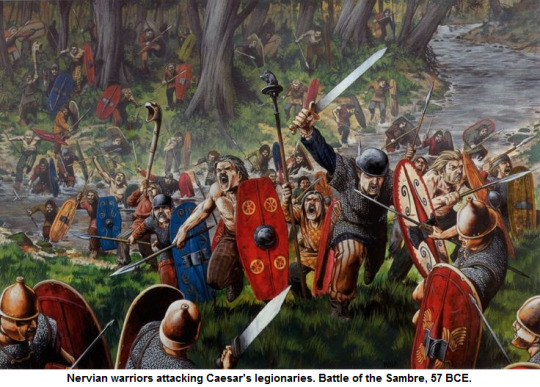
After the fall of Rome armor was once again rare amongst European warriors, but not as rare as it had been at its conception. Infantry formations would be defined by where the mail-clad soldiers were position, usually on the front ranks or at the flanks. Elbow-length sleeves were already common by the tenth century, and by the eleventh century the neck of the tunic was very often extended upwards to form an integral hood or coif. Sometimes a strip or square of mail hanged loose from the front of the hood, and could be raised and tied with tongs to cover the chin or mouth. This was called a ventail. The tunic was now long enough to cover the knees, and it was often split on the front up to just below the crotch, to make it easier to wear while riding a horse. This hooded tunic was then called a hauberk. It’s worth mentioning that hair tangles very easily with mail. Norman warriors cut their hair very short and shaved the back of their heads. It’s also possible they wore leather or fabric hoods under their mail coifs.
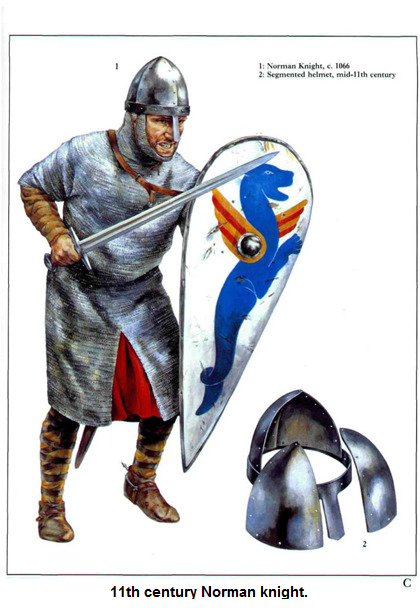
By the twelfth century, after the First Crusade, the sleeves of mail covered the entirety of the arm and often ended in a leather mitten, with the back of the hand covered in mail and a slit on the palm in case the knight needed the use of his fingers. The hauberk was commonly worn over a padded garment called a gambeson, which will be described in detail further on. A similarly padded cap was worn under the mail coif. These two added an extra degree of shock absorption to the mail, and provided a cut-resistant barrier if the rings of the mail were compromised. The legs and feet were also covered by a hose of mail tied at the back with tongs.
These were called chausses. Infantry soldiers wore similar armor, though sometimes without the coif or the mittens.

By the latter half of the thirteenth century the mail coif became separated from the hauberk, and the sleeves sometimes ended in three-finger mittens. These mittens would soon be dropped in favor of the gauntlet. The coat of plates had just been developed, but mail was invariably worn underneath it. Mail was also used to protect horses, always over some sort of padding or lining, but it was only done by the heaviest cavalry. It was also used to reinforce reins. By the end of the fourteenth century, when the solid breastplate had already come into the scene, European mail body-armor could be separated into three forms. The hauberk was the knee-length tunic with long sleeves. The haubergeon had elbow-length sleeves and covered roughly half of the thighs. A shirt of mail with very short sleeves that goes down to the hips is sometimes called a byrnie, but the term can also be applied to any tunic of mail. Broad strips of mail over padding could also be used to protect the neck by hanging from the edge of a helmet. This was called an aventail. Sometimes these had flaps that could be used to cover the face in battle and dropped when needed.

At this point it’s worth mentioning a type of armor often known was plated mail. This is simply mail armor in which metal plates replace the steel rings in certain areas, particularly around the torso. It was also used to protect the horses of heavy cavalry soldiers. This type of armor was very common in Asia and Eastern Europe, most likely popularized by the Mongols of the Golden Horde, and remained in use for centuries to come. The Japanese would develop this type of armor into the karuta tatami do, a cuirass of plated mail with a fabric backing. In the Middle East this would evolve into what’s called mirror armor, a cuirass of large plates connected with mail.
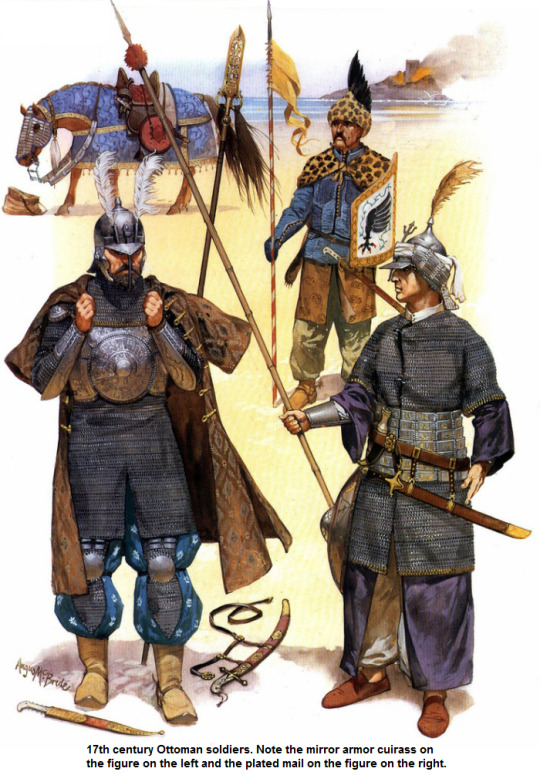
Going back to Europe, the hauberk remained in use together with the new plate armor, but this changed by the middle of the fifteenth century. While the tunics remained popular amongst more lightly armored soldiers, fully armored soldiers only used mail in the shape of sleeves, hose, collars or skirts to cover the gaps in the full plate harness. Horse armor was also made of steel plates, with mail used to cover the gaps.

During the sixteenth century the collar, hose and finally the skirt were phased out as plate armor became more complex. Mail was also used in what can be considered auxiliary armor, like a circle of mail that covered the neck and shoulders known as bishop’s mantle. Some light cavalry still used hauberks, like the Italian stradioti and the Polish-Lithuanian pancerni, as well as all kinds of irregular troops. This practice continued through the seventeenth century. The gallowglass, elite Irish infantry soldiers, also favored the long hauberk and the bishop’s mantle, even nearing the end of the sixteenth century.

The use of mail by Europeans dwindled almost into nonexistence with the eighteenth century. The only significant use it saw was in the shape of a sheet of mail made of very small rings, meant to be concealed under one’s clothes as a defense against dueling weapons, but even then it was rare at best. By contrast, mail armor remained a popular form of defense in Asia even well into the nineteenth century. India in particular is a good example of this. The numerous conflicts involving the various Indian factions and the British Empire saw a large amount of close-quarters combat, since Indian armies still favored melee weapons. Mail tunics were common, but so were amazingly elaborate examples of plated mail and mirror armor.
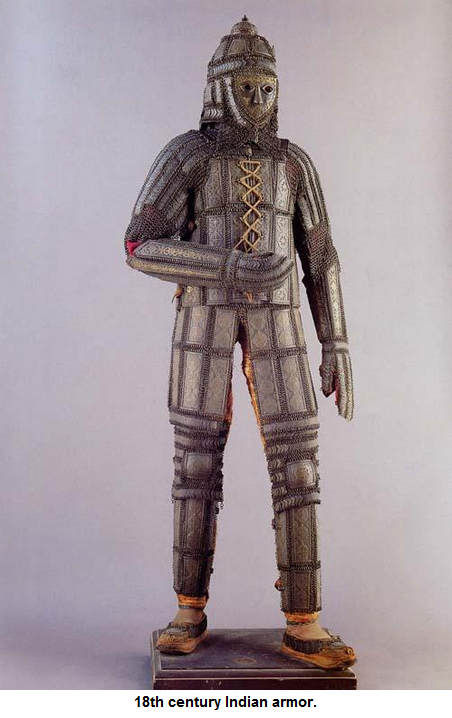
Image sources, in order:
- Get Dressed for Battle (http://gdfb.co.uk/chainmail-13-c.asp)
- Celtic Warrior by Stephen Allen (https://ospreypublishing.com/celtic-warrior-pb)
- Norman knight by Christopher Gravett (https://ospreypublishing.com/norman-knight-ad-950-1204-pb)
- English Medieval Knight 1200–1300 by Christopher Gravett (https://ospreypublishing.com/english-medieval-knight-1200-1300-pb)
- English Medieval Knight 1300–1400 by Christopher Gravett (https://ospreypublishing.com/english-medieval-knight-1300-1400-pb)
- Armies of the Ottoman Turks 1300–1774
by David Nicolle
(https://ospreypublishing.com/armies-of-the-ottoman-turks-1300-1774-pb)
- Wasson Artistry (http://www.wassonartistry.com/armor.php?w=15thcent)
- Saint Louis Art Museum (http://slam.org:8080/emuseum/view/objects/asitem/items$0040:34150)
- Stibbert Museum (http://www.museostibbert.it/en/page/islamic-armoury)
Additional Material:
- Mail: Unchained by Dan Howard (http://www.myarmoury.com/feature_mail.html)
- Introduction to mail (chainmail) armour by Matt Easton (https://www.youtube.com/watch?v=gYpFtVQlgLc)
- Mail Armour Historical Evaluation by
Raffaello Urbani
- Chainmail – some points about by Nikolas Lloyd (https://www.youtube.com/watch?v=RssIl2v0C1k)
- Chainmail – part 2 Nikolas Lloyd (https://www.youtube.com/watch?v=lahyhBeBsys)
- Chainmail – part 3 Nikolas Lloyd (https://www.youtube.com/watch?v=n-syLrpHt8w)
- Cluny Falchion v’s Maille by Falchion Archeology (https://www.youtube.com/watch?v=cXsbWnNh-To)
-
The Mail Shirt by Ian LaSpina







